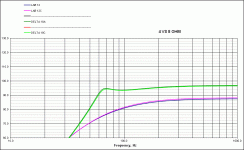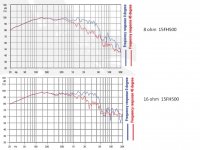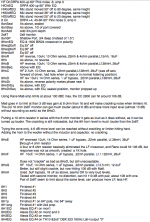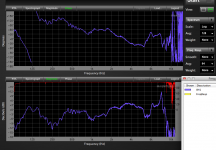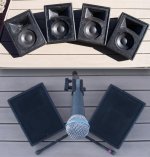I dunno, they work fine. I simply adjusted crossover parts to suit. With a passive crossover I have to attenuate anyway, so being more efficient isn't a big deal. And 16 ohms isn't either, as I just built the L-Pad to give me something like a flat 10 Ohms (IIRC.) No worries.Might I ask Pano if he formed any new oppinion based on Altec 288 16 ohm version? Thank you.
That's me, living in a magical world. 😀Ready for more flames from those who live in a magic world where these factors simply wash out.
"Ready for more flames from those who live in a magic world where these factors simply wash out.
Lots of luck learning........."
I think this argument not the first one about impedance vs sensitivity on Diyaudio, and it was a surprise for me at the first time, but I learned. 🙂
Lots of luck learning........."
I think this argument not the first one about impedance vs sensitivity on Diyaudio, and it was a surprise for me at the first time, but I learned. 🙂
Well I looked at the specs of the 2 woofers listed, the LAB12 and the Delta 18 in their 4 & 8 Ohm versions. If one goes by the T/S parameters listed, they are basically identical at 1W. Of course it takes more voltage to achieve that 1W in the 8 ohm versions, no surprise there.
Plotted from their T/S parameters, please see graphs below at 1W.
Plotted from their T/S parameters, please see graphs below at 1W.
Attachments
hey, maybe you want to know Faital Pro now have 15" woofers with 16ohm ... and specsheet showing changed Qts and response curves
FaitalPRO | LF Loudspeakers | 15FH500
FaitalPRO | LF Loudspeakers | 15FH500
hey, maybe you want to know Faital Pro now have 15" woofers with 16ohm
Hopefully useful OT.
The table compares the T/S parameters for the 8 vs 16 ohm version of the Faital 15FH500 WOOFER. Frequency plots also attached. The Faital 8 ohm has Le=1.3mH Qts=0.31, the 16 ohm has Le=2mH Qts=0.45 in the specs.
When using a 15" driver as a "midbass" a low Le is often considered desirable, and this is why there are many Lambda TD15M (0.3mH) fans. I use the Beyma CP380/M 1" polyester diaphragm compression driver - worth a look.
JFETs are just COOL tubes.
Attachments
O great Osiris hear my plea.... (he's the god of resurrection... never mind)
I'm working on my first passive XO and would like some onions (as if that needed to be specified 😛) For that last 20 years I've only gone the active route so this is new to me. Also any reference material you might suggest will be much appreciated.
I want to match this:http://www.eminence.com/pdf/Beta_10CX.pdf
To this: http://www.eminence.com/pdf/PSD2013S16.pdf
Question is would you go with the 8ohm CD or the 16ohm?
I will measure the T/S parameters once I get the drivers so this is rough work until then.
I want to use a second order butterworth on both sides which I believe will give me a 180deg polarity flip, so I can just flip polarity on the CD or woofer to compensate. XO at ~1.5-1.7KHz
These will be driven by my dads standard Yamaha AVR
(~105w 2channel driven into 8ohms)
Also, If you have any XO hints I would not be offended by suggestions.
Sincerely,
Boden
Ps. If I have made any mistakes please point them out. (another thing that didn't really need to be said 😀)
I'm working on my first passive XO and would like some onions (as if that needed to be specified 😛) For that last 20 years I've only gone the active route so this is new to me. Also any reference material you might suggest will be much appreciated.
I want to match this:http://www.eminence.com/pdf/Beta_10CX.pdf
To this: http://www.eminence.com/pdf/PSD2013S16.pdf
Question is would you go with the 8ohm CD or the 16ohm?
I will measure the T/S parameters once I get the drivers so this is rough work until then.
I want to use a second order butterworth on both sides which I believe will give me a 180deg polarity flip, so I can just flip polarity on the CD or woofer to compensate. XO at ~1.5-1.7KHz
These will be driven by my dads standard Yamaha AVR
(~105w 2channel driven into 8ohms)
Also, If you have any XO hints I would not be offended by suggestions.
Sincerely,
Boden
Ps. If I have made any mistakes please point them out. (another thing that didn't really need to be said 😀)
Last edited:
This might be a better thread for you to resurrect: http://www.diyaudio.com/forums/multi-way/242494-eminence-beta-cx-10-what-have-you-done-lately.html
I use 16 Ohm compression drivers, but I don't think it matters much. You just build the crossover for the real impedance of the drivers. You'll be padding down the drivers anyway.
I use 16 Ohm compression drivers, but I don't think it matters much. You just build the crossover for the real impedance of the drivers. You'll be padding down the drivers anyway.
Thanks, I'm trending that way.
Jeff Bagby is the man for making this excel sheet.
edit: although I'm starting to suspect he's also a little nuts... wow
Last edited:
I use 16 Ohm compression drivers, but I don't think it matters much. You just build the crossover for the real impedance of the drivers. You'll be padding down the drivers anyway.
Exactly, so you might as well use 16 ohms and not have to pad it as much.
The crossover could be kind of a mess. Often, drivers on horns give a real spiky impedance, due to various acoustic reflections in the driver/horn. So the voltage transfer function cannot be nice and neat-active crossover are indeed much better for that. IIRC, the acoustic phase of the horn/driver combo is probably not nice and smoothly changing either. So to get a true smooth 2nd order won't really happen.
To get specific, you'll really need to measure the actual impedance (magnitude AND phase) of your driver on your horn on your cabinet. Do you have equipment for that? If not, maybe someone is not too far from you who does. Then we can help you hopefully get at least close to what you want to do.
Yep. The trade off being larger inductors. But you can cheat that, if you know how.Exactly, so you might as well use 16 ohms and not have to pad it as much.
2nd order Linkwitz-Riley electrical or acoustic? What counts in the end is the acoustical slopes, not electrical.
Exactly, so you might as well use 16 ohms and not have to pad it as much.
The crossover could be kind of a mess. Often, drivers on horns give a real spiky impedance, due to various acoustic reflections in the driver/horn. So the voltage transfer function cannot be nice and neat-active crossover are indeed much better for that. IIRC, the acoustic phase of the horn/driver combo is probably not nice and smoothly changing either. So to get a true smooth 2nd order won't really happen.
To get specific, you'll really need to measure the actual impedance (magnitude AND phase) of your driver on your horn on your cabinet. Do you have equipment for that? If not, maybe someone is not too far from you who does. Then we can help you hopefully get at least close to what you want to do.
I've got a DATS V2 for doing the measurements in cabinet/"horn".
My natural inclination is to go active but my dad wants to use these with his AVR which does not have pre outs. So I thought this would be a good learning experience.
Yep. The trade off being larger inductors. But you can cheat that, if you know how.
Bogarting the information I see... 😛
2nd order Linkwitz-Riley electrical or acoustic? What counts in the end is the acoustical slopes, not electrical.
Acoustic is my goal. I suspect once I get the basic component values I will bracket them and buy extra bits so I can have options while I breadboard the system.
I figure I'll keep it simple at first with a simple XO plus Lpad on the horn.
Will the Lpad work as a damper as well? (That's what they look like with the R2 in that position.)
I'm still wrapping my head around the component positions. Functions is easy, interactions is the trick part as far as I can tell. I guess this is why fancy simulators are so handy.
Should I design the XO using an weighted(1) average impedance or just the impedance at the XO point?
(1)weighted toward the XO point
(1)weighted toward the XO point
Show us the measured impedance response of your drivers in the cabinets on the horns and we'll let you know...Should I design the XO using an weighted(1) average impedance or just the impedance at the XO point?
(1)weighted toward the XO point
Below are the tests and revisions I went through for creating a passive crossover using an Eminence Alpha 8" and a Eminence PSD2002 on my 90x40 constant directivity horn. Although all of the dozens of Eminence woofers I have tested are remarkably consistent in frequency response, none of their HF drivers I have owned (PSD2002 and APT) have had consistent response.
Not to bore you with the entire blow by blow report, but at revision "Dr", thought the crossover design was done- it had flat frequency and phase response through the 1300 Hz acoustical crossover region. It played fine using a Crest CC2800 amp, but the Rane Ma6 amp I planned to use with the monitors couldn't handle the load without making horrible cracking noises when it hit limit.
After four more revisions, got a frequency and phase response not quite as good as revision "Dr", but could hang a pair on a channel of the Rane Ma6 (about 75 watts per cabinet) and hit 110 dB at about 6 feet outdoors, good enough for the more quiet and gentle life I lead having retired from pro "sound by the pound".
Art
Attachments
Show us the measured impedance response of your drivers in the cabinets on the horns and we'll let you know...
Below are the tests and revisions I went through for creating a passive crossover using an Eminence Alpha 8" and a Eminence PSD2002 on my 90x40 constant directivity horn. Although all of the dozens of Eminence woofers I have tested are remarkably consistent in frequency response, none of their HF drivers I have owned (PSD2002 and APT) have had consistent response.
Not to bore you with the entire blow by blow report, but at revision "Dr", thought the crossover design was done- it had flat frequency and phase response through the 1300 Hz acoustical crossover region. It played fine using a Crest CC2800 amp, but the Rane Ma6 amp I planned to use with the monitors couldn't handle the load without making horrible cracking noises when it hit limit.
After four more revisions, got a frequency and phase response not quite as good as revision "Dr", but could hang a pair on a channel of the Rane Ma6 (about 75 watts per cabinet) and hit 110 dB at about 6 feet outdoors, good enough for the more quiet and gentle life I lead having retired from pro "sound by the pound".
Art
Art,
Once I get the drivers (ordered today 😀) and build the boxes I will definitely post everything. Thank you
Sincerely,
Boden
Yes, please post. Real measurements are essential to building a good crossover. (At least for most of us).
Art. It took me quite a few seconds to figure out the photo with microphone. At first I thought they were tiny speakers. LOL!
Art. It took me quite a few seconds to figure out the photo with microphone. At first I thought they were tiny speakers. LOL!
Gaaaaahhhhh!!!!! My DATS test box died today while I was playing with some other speakers while waiting for UPS to deliver the drivers...
 *swearing, stomping, general discontent*
*swearing, stomping, general discontent* 
The replacement will not be here until Nov. 7
I am not happy.
The drivers look nice though... sitting there mocking me

 *swearing, stomping, general discontent*
*swearing, stomping, general discontent* 
The replacement will not be here until Nov. 7
I am not happy.
The drivers look nice though... sitting there mocking me

- Status
- Not open for further replies.
- Home
- Loudspeakers
- Multi-Way
- 1" Compression driver 8 ohm vs 16ohm
